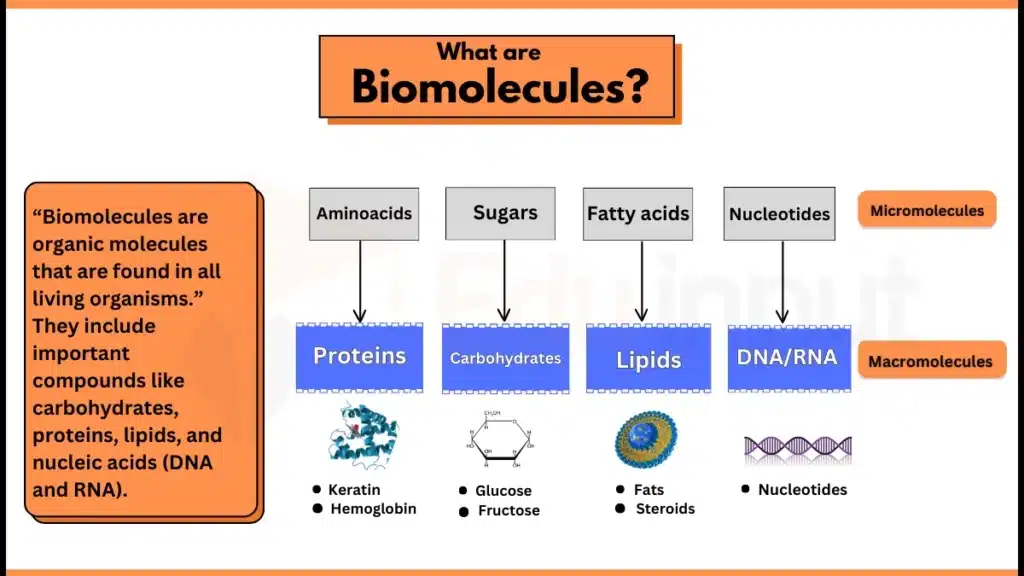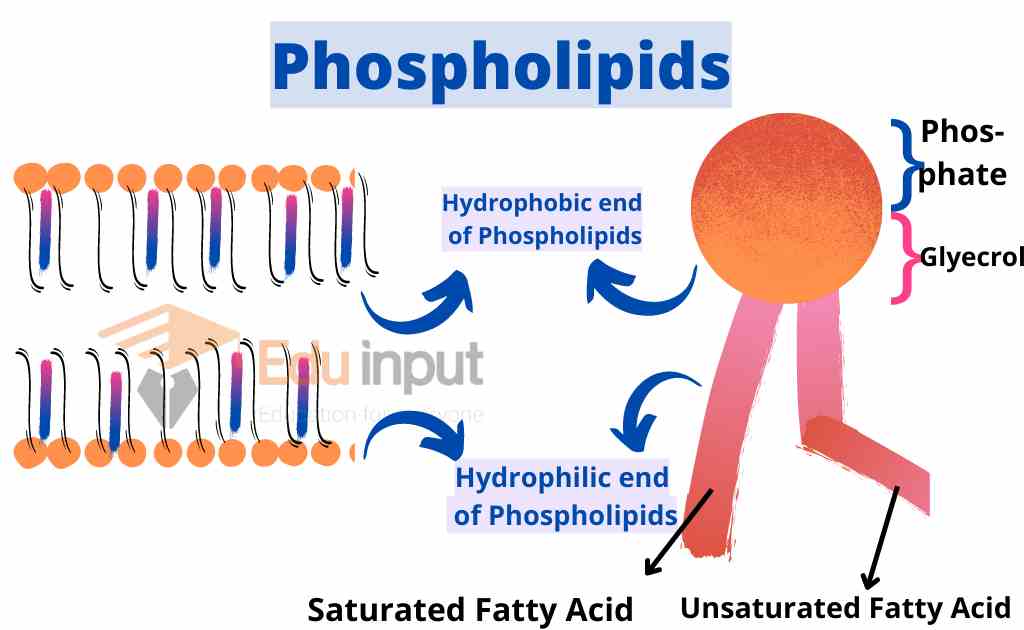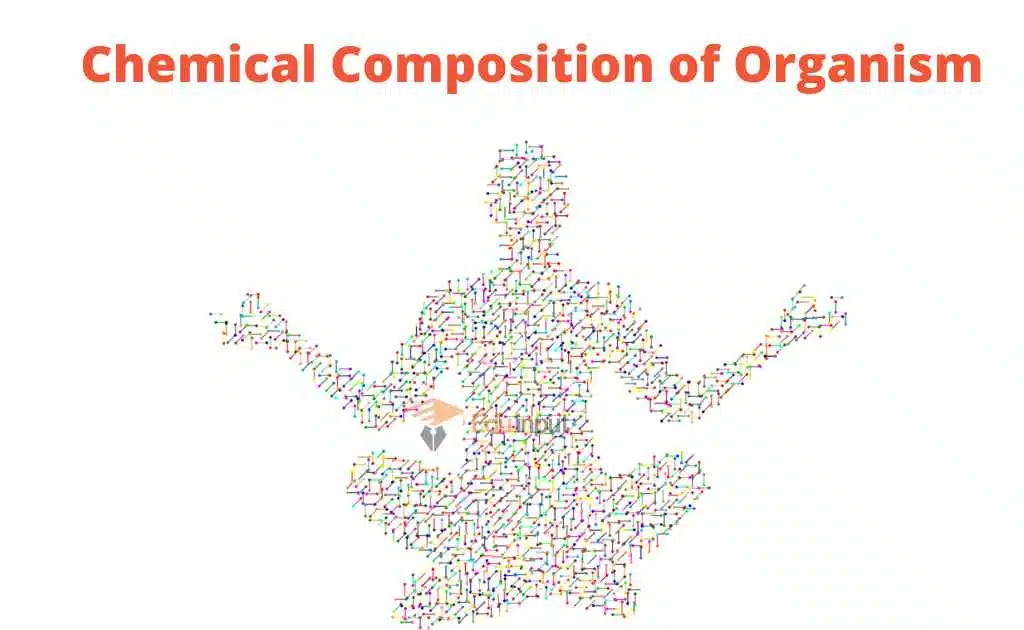Biological Molecules- Definition, Types and functions
Definition
Any organic molecule produced in a living organism is called Biomolecule. Biomolecules play a crucial role in maintenance and functioning of organism’s body. They are important for biological processes like growth, repair, metabolic procedures, and energy production.

Biomolecules include both micromolecules and macromolecules. Small molecules, like nutrients and hormones are micro molecules while large molecules such as carbohydrates, proteins, DNA and fats are macromolecules. They can vary in types, natures, structure and physical properties.
4 Types of Biological molecules and their functions
Biological molecules have two primary types as micromolecules and macromolecules. But macromolecules are present abundantly so these are considered as the major biomolecules. So, the types of these biomolecules are described below:
1. Carbohydrates
Carbohydrates, also known as polysaccharides, are made up of smaller sugar units called monosaccharides. ‘Saccharide’ is the structural unit of carbohydrates. Carbohydrates are most abundant among macromolecules. Functions of carbohydrates include energy production, storage, and building cellular structures. And that’s how they play an important role in living cells.
The formula of carbohydrates is Cn (H₂O)n, meaning they are “hydrates of carbon.” However, some carbohydrates have slightly different structures and don’t exactly follow this formula.
Based on their monomeric units, carbohydrates are classified in 4 types:
- Monosaccharides consist of only one simple sugar. Examples include glucose, fructose, and galactose.
- Disaccharides are made up of two monosaccharides. Examples are sucrose, maltose, and lactose.
- Oligosaccharides consists of two to ten monosaccharide units. Examples, include stachyose, maltotriose, and cyclodextrins.
- Polysaccharides involve a larger number of monosaccharides. Examples are starch, cellulose, and glycogen.
2. Proteins
Proteins are large biomolecules made of 20 different amino acids, which are the building blocks of proteins. These amino acids are joined together through peptide bonds and build long chains called polypeptides. Each amino acid has a central ‘carbon’ attached to an amino group (NH₂), a carboxyl group (COOH), a hydrogen atom, and a unique side chain (R group) that defines its type. For example, glycine has hydrogen (H) as its side chain, while serine has a CH₂OH group. Hence, the formula of protein is (NH2CHRCOOH)
There are about a hundred natural amino acids, but only twenty are used to make proteins. Proteins are essential for different functions, including structure building (like keratin), transport substances (like hemoglobin), and acting as enzymes and antibodies.
In proteins, 11 amino acids are “non-essential (produced by the body)”, while 9 are “essential” and must be obtained from food.
3. Nucleic Acids
Nucleic acids are long-chain molecules that are made up of smaller units called nucleotides. Nucleic acids contain all the genetic information in form of DNA and RNA.
Each nucleotide contains three main components: a nitrogenous base, a sugar, and a phosphate group. The base (purines and pyrimidines) connects with a sugar and forms a ‘nucleoside’. When a nucleoside linked with a phosphate group, it becomes a ‘nucleotide’. These nucleotides joined together through phosphodiester bond to form nucleic acids like DNA or RNA.
DNA is a double stranded nucleic acid. These strands twist around each other to form a helix. While RNA is a single-stranded nucleic acid, made up of of repeating nucleotide units of ribose sugar, phosphate group and a nitrogenous base. The difference between DNA and RNA is based on their sugar backbone and nitrogenous base (DNA contains thymine while RNA contains uracil).
Function of DNA and RNA includes replication, and expression of genetic information in all living organisms. Aside from nucleic acids, cells need different other biological molecules for specific functions and procedures.
4. Lipids
Glycerol and fatty acids are the building blocks of lipids. Unlike carbohydrates, proteins, and nucleic acids, lipids are not composed of repeating units, so they are not polymers. Lipids are a type of organic molecules that play their role in storing energy, building cell structures and some other essential functions.
A lipid molecule is made up of the same basic elements as carbohydrates: carbon, hydrogen, and oxygen atoms. The structure of lipid molecule includes ‘a glycerol backbone’ and ‘hydrocarbon tails’.
Examples of lipids include fats, oils, waxes, sterols, and molecules like phospholipids, which help make up cell membranes.







Leave a Reply